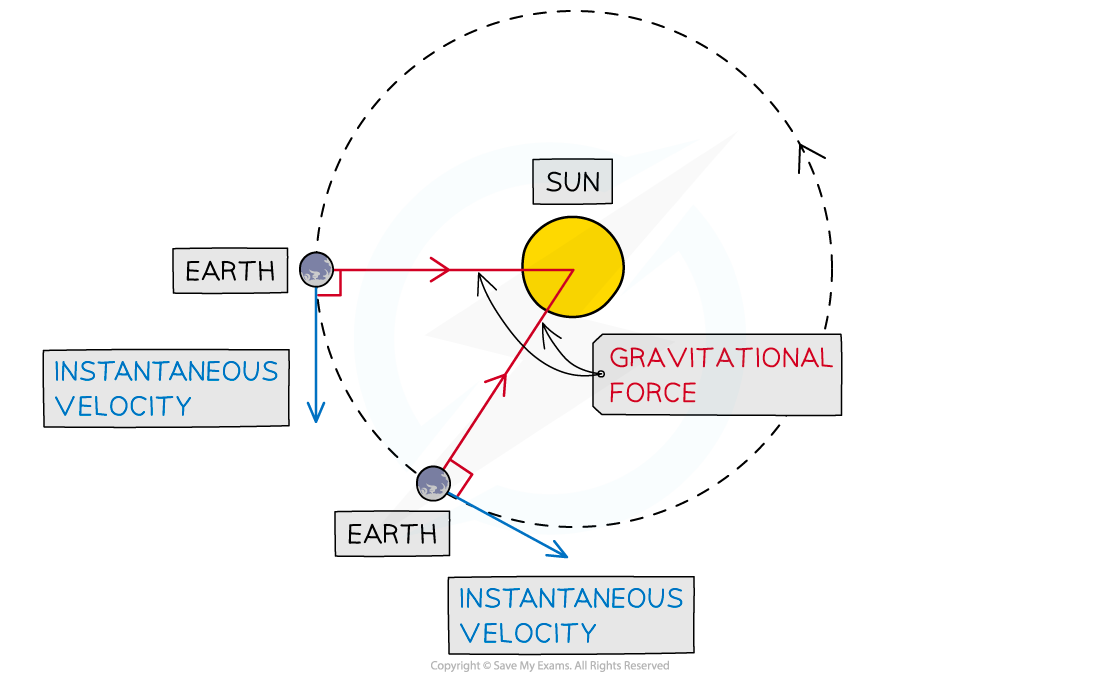Circular Orbits (Edexcel GCSE Physics): Revision Note
Exam code: 1PH0
Orbiting Bodies
There are many orbiting objects in our solar system and they each orbit a different type of planetary body
Orbiting Objects or Bodies in Our Solar System Table

A smaller body or object will orbit a larger body
For example, a planet orbiting the Sun
In order to orbit a body such as a star or a planet, there has to be a force pulling the object towards that body
Gravity provides this force
The gravitational force exerted by the larger body on the orbiting object is always attractive
Therefore, the gravitational force always acts towards the centre of the larger body
The gravitational force will cause the body to move and maintain in a circular path

Gravitational attraction causes the Moon to orbit around the Earth
Orbits of Planets
There are several similarities in the way different planets orbit the Sun:
Their orbits are all slightly elliptical (stretched circles) with the Sun at one focus (approximately the centre of the orbit)
They all orbit in the same plane
They all travel the same direction around the Sun
There are also a few differences:
They orbit at different distances from the Sun
They orbit at different speeds
They all take different amounts of time to orbit the Sun

The orbits of planets around the Sun
Orbits of Moons
Moons orbit planets in a circular path
Some planets have more than one moon
The closer the moon is to the planet:
The shorter the time it will take to orbit
The greater the speed of the orbit
Comets
The orbits of comets are very different to those of planets:
Their orbits are highly elliptical (very stretched) or hyperbolic
This causes the speed of the comets to change significantly as their distance from the Sun changes
Not all comets orbit in the same plane as the planets and some don’t even orbit in the same direction

The elliptical orbit of a comet
Artificial Satellites
A satellite needs to travel at a specific speed to maintain a circular orbit at a particular distance from the object
If the speed of the satellite is too large:
The radius of the orbit will increase and the satellite will spiral into space
This is because the gravitational attraction cannot provide enough force to keep it in orbit
If the speed of the satellite is too low:
The radius of the orbit will decrease and the satellite will move towards the object it should be orbiting
This is because the gravitational attraction is too strong to maintain a constant orbital radius

Diagram showing how the speed of an artificial satellite affects its orbit
If an artificial satellite is to change the radius at which it is orbiting then the speed at which it is travelling must change
To maintain a stable orbit:
If the speed increases the radius must decrease
If the speed decreases the radius must increase
Did this video help you?
Circular Orbits
Planets travel around the Sun in orbits that are (approximately) circular
Objects in circular orbit are travelling at a constant speed but a changing velocity
In a circular path, the direction in which the object is travelling will be constantly changing direction
A change in direction causes a change in velocity
Acceleration is the rate of change of velocity
Therefore, if the object is constantly changing direction then its velocity is constantly changing and so the object in orbit is accelerating
A resultant force is needed to cause an acceleration
This resultant force is gravity and it must act at right angles to the instantaneous velocity of the object to create a circular orbit
This is always towards the centre of the orbit
The instantaneous velocity of the object is the velocity at a given time

The direction of the instantaneous velocity and the gravitational force at different points of the Earth’s orbit around the sun

Unlock more, it's free!
Did this page help you?